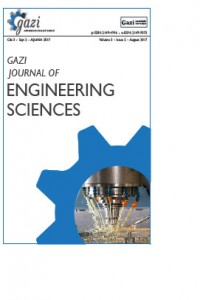Abstract
In this study, the cutting performance of 8.8mm diameter, helical solid comentite carbide, two mouths features with a original solid cementite carbide drill was investigated usign finite element analysis method. For this purpose, AISI 1045 workpiece drilling operations with different cutting parameters of the material was carried out experimentally. To obtained experimental data with different cutting parameters were confirmed by the finite element model. Factors affecting the cutting performance; cutting forces, cutting temperatures and chip formattion were compared. Deform-3D software was used to construct the cutting mechanism. For cutting tool and workpiece material parameters, related software’s material library was also used. As a result, when the results of the experiments and finite element analysis are evaluated, prepared finite element model has emerged give suitable results to the actual model.
References
- [1] Grzesik W. Advanced machining processes of metallic materials. Elsevier 2008.
- [2] Filice L., Micari F., Rizutti S., Umbrello D. A critical analysis on the friction modelling in orthogonal machining. International Journal of Machine Tools & Manufacture, 2007, 47: 709-714.
- [3] Özel T. The influence of friction models on finite element simulations of machining. International Journal of Tools & Manufacture, 2006, 46: 518-530.
- [4] Bil H. Simulation of orthogonal metal cutting by finite element analysis. Ortadoğu Teknik Üniversitesi, Makine Mühendisliği Bölümü, Yüksek lisans tezi, 2003, Ankara.
- [5] Jaspers S.P.F.C, Dautzenberg J.H. Material behaviour in conditions similar to metal cutting: flow stres in the primary shear zone. Journal of Materials Processing Technology, 2002, 122:322-330.
- [6] Iqbal S.A., Mativenga P.T., Sheikh M.A. Characterization of machining of AISI 1045 steel over a wide range of cutting speeds. Part2 : evaluation of flow stress models and interface friction distribution schemes. Journal Engineering Manufacure Proc. Imech, 2007, 221:233-237. Doi:10.1243/09544054JEM797
- [7] Sekar K.S.V., Kumar M.P. An Investigation into the Effect of Three-flow Stress Models on the Finite Element Simulation of Orthogonal Cutting of AISI 1045 Steel. The Institution of Engineers, 2009, 89:01-10.
- [8] DEFORM 3D Machining Analysis V10.2 Material Library, 2006.
- [9] GRANTA Materials Information Technology, 2016.
- [10] Mendi F. Takım tezgahları teori ve hesapları, ISBN 975-96008, 1996, 5-40, Ankara.
- [11] Çakıroğlu R. Delik Delme İşlemlerinde Kesme Parametrelerine Bağlı Olarak Oluşan Sıcaklığın Modellenmesi. Gazi Üniversitesi Fen Bilimleri Enstitüsü, Yüksek Lisans Tezi, 2011, Ankara.
- [12] Yağmur S., Delik Delme İşlemlerinde Kesme Parametrelerine Bağlı Olarak Oluşan Sıcaklığın Deneysel Olarak İncelenmesi. Gazi Üniversitesi, Fen Bilimleri Enstitüsü, Yüksek Lisans Tezi, , 2011, Ankara.
Abstract
Bu çalışmada, sementit karbür matkaplar ile delik delme uygulamalarında, kesme parametrelerinin delme performansına etkisi, sonlu elemanlar metotları ve deneysel çalışmalar ile incelenmiştir. Çalışmalarda 8.8mm çaplı iki ağızlı sementit karbür matkap ve AISI 1045 iş parçası malzemesi kullanılmıştır. Kesme parametrelerinin belirlenmesinde, kuru delme işlemi uygulanmıştır. Farklı kesme parametreleriyle elde edilen deneysel veriler sonlu elemanlar analizleri ile karşılaştırılmıştır. Sonlu elemanlar analizi için Deform-3D yazılımından yararlanılmıştır. Malzeme modeli yazılımın malzeme kütüphanesinden elde edilmiştir. Sonuç olarak, deneysel çalışmalar sonucu elde edilen kesme kuvvetleri ve talaş oluşumları incelendiğinde, sonlu elemanlar modelinin gerçek sonuçlara yakın veriler sağlayabileceği gözlemlenmiştir.
References
- [1] Grzesik W. Advanced machining processes of metallic materials. Elsevier 2008.
- [2] Filice L., Micari F., Rizutti S., Umbrello D. A critical analysis on the friction modelling in orthogonal machining. International Journal of Machine Tools & Manufacture, 2007, 47: 709-714.
- [3] Özel T. The influence of friction models on finite element simulations of machining. International Journal of Tools & Manufacture, 2006, 46: 518-530.
- [4] Bil H. Simulation of orthogonal metal cutting by finite element analysis. Ortadoğu Teknik Üniversitesi, Makine Mühendisliği Bölümü, Yüksek lisans tezi, 2003, Ankara.
- [5] Jaspers S.P.F.C, Dautzenberg J.H. Material behaviour in conditions similar to metal cutting: flow stres in the primary shear zone. Journal of Materials Processing Technology, 2002, 122:322-330.
- [6] Iqbal S.A., Mativenga P.T., Sheikh M.A. Characterization of machining of AISI 1045 steel over a wide range of cutting speeds. Part2 : evaluation of flow stress models and interface friction distribution schemes. Journal Engineering Manufacure Proc. Imech, 2007, 221:233-237. Doi:10.1243/09544054JEM797
- [7] Sekar K.S.V., Kumar M.P. An Investigation into the Effect of Three-flow Stress Models on the Finite Element Simulation of Orthogonal Cutting of AISI 1045 Steel. The Institution of Engineers, 2009, 89:01-10.
- [8] DEFORM 3D Machining Analysis V10.2 Material Library, 2006.
- [9] GRANTA Materials Information Technology, 2016.
- [10] Mendi F. Takım tezgahları teori ve hesapları, ISBN 975-96008, 1996, 5-40, Ankara.
- [11] Çakıroğlu R. Delik Delme İşlemlerinde Kesme Parametrelerine Bağlı Olarak Oluşan Sıcaklığın Modellenmesi. Gazi Üniversitesi Fen Bilimleri Enstitüsü, Yüksek Lisans Tezi, 2011, Ankara.
- [12] Yağmur S., Delik Delme İşlemlerinde Kesme Parametrelerine Bağlı Olarak Oluşan Sıcaklığın Deneysel Olarak İncelenmesi. Gazi Üniversitesi, Fen Bilimleri Enstitüsü, Yüksek Lisans Tezi, , 2011, Ankara.
Details
| Subjects | Mechanical Engineering |
|---|---|
| Journal Section | Research Articles |
| Authors | |
| Publication Date | April 10, 2017 |
| Submission Date | June 23, 2017 |
| Acceptance Date | April 10, 2017 |
| Published in Issue | Year 2017 Volume: 3 Issue: 1 |



